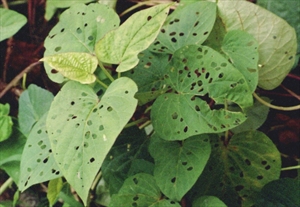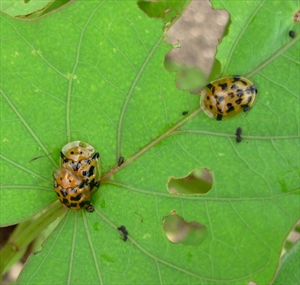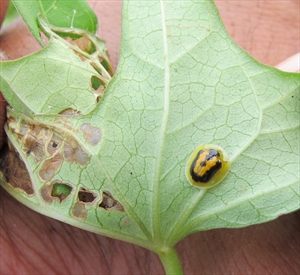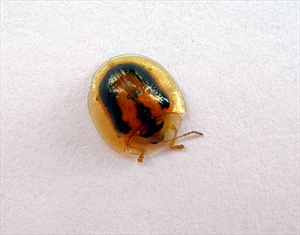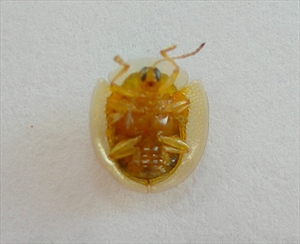Sweetpotato tortoise beetle
Pacific Pests, Pathogens, Weeds & Pesticides - Online edition
Pacific Pests, Pathogens, Weeds & Pesticides
Sweetpotato tortoise beetle (054)
Cassida and Aspidimorpha species.
Asia and Oceania. There are many Cassida and Aspidimorpha species in Pacific island countries, almost all feeding on Convolvulaceae. The following have been recorded on sweetpotato: Cassida compuncta (Fiji); Cassida diomma (Fiji and Samoa); Cassida papuana (Papua New Guinea and Solomon Islands), and Cassida species on Merremia peltata (Solomon Islands).
Sweetpotato, kangkong (Ipomoea aquatica), and related Ipomoea species (plants in the morning glory family). Possibly, the beetles feed on crops and weeds in other families.
Adults feed on leaves, making small to medium-size holes (Photos 1-3). The larvae at first eat the leaf surface; later, they eat their way through the leaf.
The oval eggs (1-2 mm long) are laid individually on the leaves in a small papery parcel. The larvae have spines, and an anal fork. The anal fork is made up of long spines near the tip of the abdomen, and these hold the old skins - which are not shed completely - mixed with excreta (faeces, frass or 'droppings'). The 'tail' of old skins is carried over the back of the body, and can be moved about by the anal fork, probably to deter predators. The larvae pass through five moults, before a pupal stage develops. The pupae are attached by the tail end to the underside of a leaf.
The adults are about 5 mm diameter, oval and slightly flattened and squared at the shoulders (Photos 4-6). The head and appendages of the adult are mostly hidden by transparent parts of the thorax and the wing covers (Photos 2-5).
The effect on storage root yield is not known in Solomon Islands, but it is unlikely to be large. It is uncommon for tortoise beetles to become a serious pest.
Look for the golden round beetles, and the clear, wing margins that cover most of the head and thorax, and extend beyond the body, covering legs and other appendages.
NATURAL ENEMIES
Tortoise beetles are attacked by (chalcid) wasps in other countries, parasitic flies, and lady beetle larvae. It is likely that these parasites and predators attack tortoise beetles in Pacific island countries, but this is not known for certain.
CULTURAL CONTROL
The following is important:
Before planting:
- Avoid planting new crops next to those already infested with the beetles.
During growth:
- Provide conditions for healthy, rapid plant growth, especially for vine cuttings after planting; these may include manures, mulches and/or commercial fertilizers, and adequate water.
- Remove weeds (especially those in the Convolvulaceae family) from around the garden to reduce the beetle number.
After harvest:
- Harvest the infested crop, collect the vines and destroy them, and then plant a new crop.
RESISTANT VARIETIES
None known, but fast-growing varieties are more likely to outgrow the damage caused by the beetles.
CHEMICAL CONTROL
If chemical control is needed, do the following:
- Ash may be effective against sweetpotato tortoise beetles. Apply to the crop as soon as the pests are seen; do not wait until the population is high. (See Fact Sheet no. 56).
- Alternatively, add ½ cup of wood ash and ½ cup of lime in 4 L water; leave to stand for some hours; strain; test on a few infested plants first to make adjustment to the strength before going into large-scale spraying.
- Use plant-derived products, such as derris, pyrethrum or chilli (with the addition of soap).
- Note, a variety of Derris, brought many years ago to Solomon Islands from Papua New Guinea, is effective as a spray. It contains rotenone, an insecticide, so it should be used with caution. There may be varieties of Derris (fish poisons) in your country that can be tried (see Fact Sheet no. 56).
- Alternatively, synthetic pyrethroids are likely to be effective, but will also kill natural enemies.
____________________
When using a pesticide (or biopesticide), always wear protective clothing and follow the instructions on the product label, such as dosage, timing of application, and pre-harvest interval. Recommendations will vary with the crop and system of cultivation. Expert advice on the most appropriate pesticide to use should always be sought from local agricultural authorities.
AUTHORS Helen Tsatsia & Grahame Jackson
Information from Chris Reid (pers. comm.), Australian Museum, Sydney; and from Tortoise and spotted cucumber beetles on sweet potato (2012) ONspecialitycrops. (https://onspecialtycrops.ca/2012/08/10/tortoise-and-spotted-cucumber-beetles-on-sweet-potatoes/). Photo 2 Graham Teakle, Canberra. Photo 6 Mani Mua, SPC, Sigatoka, Fiji.
Produced with support from the Australian Centre for International Agricultural Research under project PC/2010/090: Strengthening integrated crop management research in the Pacific Islands in support of sustainable intensification of high-value crop production, implemented by the University of Queensland and the Secretariat of the Pacific Community.
